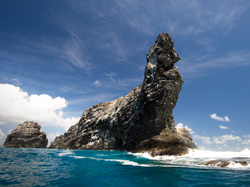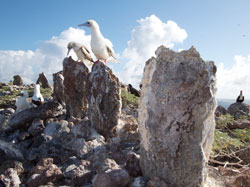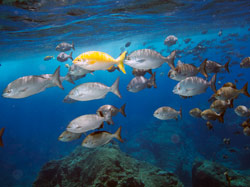Aloha! Welcome to Papahānaumokuākea Marine National Monument
– where nature and culture are one
The Name
The name Papahānaumokuākea commemorates the union of two Hawaiian ancestors – Papahānaumoku and Wākea – who gave rise to the Hawaiian Archipelago, the taro plant, and the Hawaiian people.
VisionTo forever protect and perpetuate ecosystem health and diversity and Native Hawaiian cultural significance of Papahānaumokuākea.MissionTo carry out seamless integrated management to ensure ecological integrity and achieve strong, long-term protection and perpetuation of NWHI ecosystems, Native Hawaiian culture, and heritage resources for current and future generations. |
Papahānaumokuākea Marine National Monument is the largest contiguous fully protected conservation area under the U.S. flag, and one of the largest marine conservation areas in the world. It encompasses 139,797 square miles of the Pacific Ocean (362,073 square kilometers) - an area larger than all the country's national parks combined. (See map)
The Northwestern Hawaiian Islands Marine National Monument was established by Presidential Proclamation 8031 on June 15, 2006 under the authority of the Antiquities Act (16 U.S.C. 431-433). It was expressly created to protect an exceptional array of natural and cultural resources. A year later, it was given its Hawaiian name, Papahānaumokuākea. (Learn more about the meaning, pronunciation and significance of our name here.)
Nature
The extensive coral reefs found in Papahānaumokuākea - truly the rainforests of the sea - are home to over 7,000 marine species, one quarter of which are found only in the Hawaiian Archipelago. Many of the islands and shallow water environments are important habitats for rare species such as the threatened green turtle and the endangered Hawaiian monk seal, as well as the 14 million seabirds representing 22 species that breed and nest there. Land areas also provide a home for four species of bird found nowhere else in the world, including the world's most endangered duck, the Laysan duck.
Culture
Papahānaumokuākea is of great importance to Native Hawaiians, with significant cultural sites found on the islands of Nihoa and Mokumanamana, both of which are on the National and State Register for Historic Places. Mokumanamana has the highest density of sacred sites in the Hawaiian Archipelago and has spiritual significance in Hawaiian cosmology (learn more). Papahānaumokuākea is also home to a variety of post-Western-contact historic resources, such as those associated with the Battle of Midway and 19th century commercial whaling (learn more).
World Heritage
On July 30, 2010, Papahānaumokuākea was inscribed as a mixed (natural and cultural) World Heritage Site by the delegates to the United Nations Educational, Scientific and Cultural Organization's (UNESCO) 34th World Heritage Convention in Brasilia Brazil. It is the first mixed UNESCO World Heritage Site in the United States and the second World Heritage Site in Hawaiʻi (learn more).
History
Various protection efforts in the region have been enacted over the century, beginning in 1903 when President Theodore Roosevelt sent in the U.S. Marines to stop the slaughter of seabirds for feathers and eggs at Midway Atoll. Over the next 100 years, six U.S. Presidents and one Hawai'i Governor afforded the region increasing protection (learn more).
Management
The Monument has a unique co-management structure, with three Co-Trustees and seven Co-managing agencies (learn more). These groups work together to achieve the Monument's vision and mission.
For more information, see:



